

A Brief Overview of Unsupervised Clustering Methods. True pt Olfa Nasraoui Department of Computer Engineering & Computer Science University of Louisville, olfa.nasraoui_AT_louisville.edu.
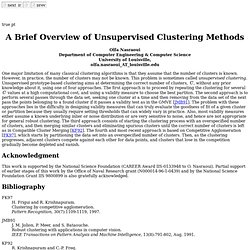
Official VideoLectures.NET Blog » 100 most popular Machine Learning talks at VideoLectures.Net. Enjoy this weeks list!
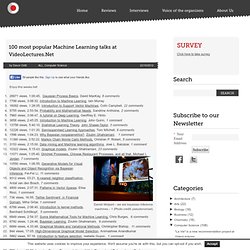
26971 views, 1:00:45, Gaussian Process Basics, David MacKay, 8 comments7799 views, 3:08:32, Introduction to Machine Learning, Iain Murray16092 views, 1:28:05, Introduction to Support Vector Machines, Colin Campbell, 22 comments5755 views, 2:53:54, Probability and Mathematical Needs, Sandrine Anthoine, 2 comments7960 views, 3:06:47, A tutorial on Deep Learning, Geoffrey E. Good Freely Available Textbooks on Machine Learning.
[resource] AI resources used in the course. Robots.stanford.edu/cs221/ What is this course about?

What do web search, speech recognition, face recognition, machine translation, autonomous driving, and automatic scheduling have in common? These are all complex real-world problems, and the goal of artificial intelligence (AI) is to tackle these with rigorous mathematical tools.
Confusion matrix for multiclass multilabel classification. Solving Every Sudoku Puzzle. By Peter Norvig In this essay I tackle the problem of solving every Sudoku puzzle.
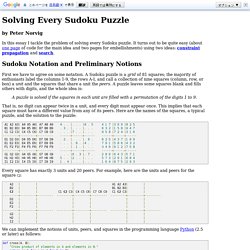
It turns out to be quite easy (about one page of code for the main idea and two pages for embellishments) using two ideas: constraint propagation and search. Sudoku Notation and Preliminary Notions First we have to agree on some notation. A Sudoku puzzle is a grid of 81 squares; the majority of enthusiasts label the columns 1-9, the rows A-I, and call a collection of nine squares (column, row, or box) a unit and the squares that share a unit the peers. A puzzle is solved if the squares in each unit are filled with a permutation of the digits 1 to 9. That is, no digit can appear twice in a unit, and every digit must appear once. Every square has exactly 3 units and 20 peers. Clustering - How do you test an implementation of k-means?
Jmlr.csail.mit.edu/proceedings/papers/v9/telgarsky10a/telgarsky10a.pdf. 5 Principles for Applying Machine Learning Techniques - Factual Blog. Here at Factual we apply machine learning techniques to help us build high quality data sets out of the gnarly mass of data that we gather from everywhere we can find it.
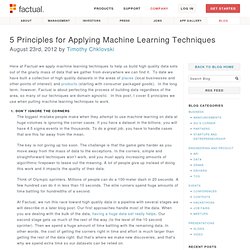
To date we have built a collection of high quality datasets in the areas of places (local businesses and other points of interest) and products (starting with consumer packaged goods). In the long term, however, Factual is about perfecting the process of building data regardless of the area, so many of our techniques are domain agnostic. In this post, I cover 5 principles we use when putting machine learning techniques to work. 1. Don’t Ignore the Corners The biggest mistake people make when they attempt to use machine learning on data at huge volumes is ignoring the corner cases. The key is not giving up too soon. Think of Olympic sprinters. At Factual, we run this race toward high quality data in a pipeline with several stages we will describe in a later blog post. 2. 3. 4. 5. Networks, Crowds, and Markets: A Book by David Easley and Jon Kleinberg. In recent years there has been a growing public fascination with the complex "connectedness" of modern society.

This connectedness is found in many incarnations: in the rapid growth of the Internet and the Web, in the ease with which global communication now takes place, and in the ability of news and information as well as epidemics and financial crises to spread around the world with surprising speed and intensity. These are phenomena that involve networks, incentives, and the aggregate behavior of groups of people; they are based on the links that connect us and the ways in which each of our decisions can have subtle consequences for the outcomes of everyone else.
Networks, Crowds, and Markets combines different scientific perspectives in its approach to understanding networks and behavior. The book is based on an inter-disciplinary course that we teach at Cornell. Machine learning - K-Means Algorithm. Neural Network Toolbox. Genetic Algorithms in Ruby, Part IRubySource. Charles Darwin produced the theory of the “survival of the fittest” (though the term was coined by Herbert Spencer), which means that the fittest and quickest adapting organisms in a specific environment will always prevail over the others.
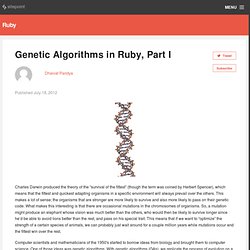
This makes a lot of sense; the organisms that are stronger are more likely to survive and also more likely to pass on their genetic code. What makes this interesting is that there are occasional mutations in the chromosomes of organisms. So, a mutation might produce an elephant whose vision was much better than the others, who would then be likely to survive longer since he’d be able to avoid lions better than the rest, and pass on his special trait. This means that if we want to “optimize” the strength of a certain species of animals, we can probably just wait around for a couple million years while mutations occur and the fittest win over the rest. If you didn’t really understand much of the above, that’s perfectly fine. Details Organism Fitness.